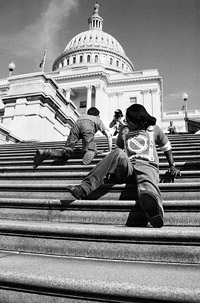Media/Arts
A stirring, uncomfortable film, Lives Worth Living chronicles the struggles and successes of the disability rights movement. It shows how Americans with many different disabilities banded together with ever-increasing militancy to fight for public access and independence. This movement demonstrated, once again, that no matter how honorable a cause may be, getting people’s attention often requires “hitting them over the head.” Lives Worth Living provides examples of people with disabilities taking extraordinary steps and defying rules to advance their cause. When we consider the changes we have seen in so many areas of life, from closed captioning to wheelchair-accessible sidewalks to building accessibility to reasonable accommodations for employment, this movement has been nothing short of a revolution. In the 1960s and ’70s, the disability rights movement took shape and coincided with other important social changes. Many people with severe psychiatric illnesses and developmental disabilities, who previously would have spent their lives in hospitals, were given the opportunity to live in community settings. The growth of social work as a profession and the proliferation of community mental health centers were tied directly to the efforts to find placements and provide support and services for these deinstitutionalized individuals. Social workers were on the frontline, helping thousands of people with the difficult transition from institutional life to independent and semi-independent settings. With a person-in-environment theoretical orientation, social workers were in the best position of all the helping professions to understand the complex interactions of clinical conditions, therapeutic milieus, and psychiatric interventions. Social work’s commitment to social justice and client advocacy also brought about the profession’s vanguard position in the community mental health movement. In the film, the organizers of the disability rights movement discuss how they looked to civil rights and feminist leaders to help them plan strategy and articulate ideas. There are compelling scenes of physically disabled people climbing and pulling themselves up the 100 steps of the U.S. Capitol to draw attention to the issues of access to public buildings and the need for legislation to protect the rights of the disabled. A young girl with cerebral palsy, while slowly and painfully climbing the stairs, shouts with extreme determination, “I’ll take all night if I have to!” These demonstrations and subsequent legislative battles eventually secured the 1990 passage of the Americans With Disabilities Act (ADA). In another very strong scene, Sen. Tom Harkin (D-IA) introduces the ADA on the Senate floor. He uses sign language to communicate to his deaf brother that “this is my proudest day in Congress.” The ADA, which is referred to in this excellent documentary as the “Emancipation Proclamation for people with disabilities.” This legislation has opened many doors, but efforts to end discrimination and improve the public’s understanding of disabilities are ongoing and probably unending. Lives Worth Living originally aired on PBS’s award-winning weekly series Independent Lens. For more information about this documentary, including how to purchase the DVD and when it will be telecast on a PBS station in your area, go to www.pbs.org/independentlens/lives-worth-living. — Robert DeLauro, MSW, ACSW, is a freelance writer and consultant with the Labor Management Project in New York City. |

 A Film Review of Lives Worth Living
A Film Review of Lives Worth Living